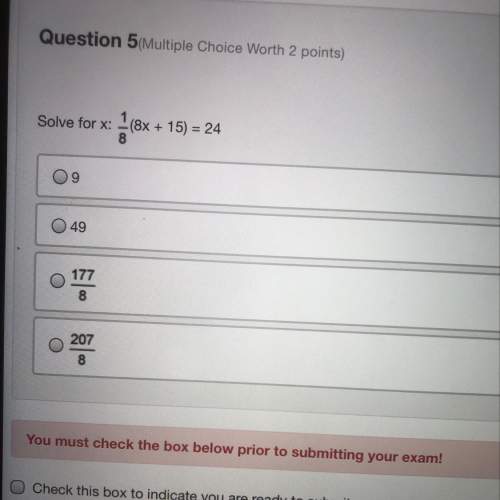
Mathematics, 18.09.2019 00:20 carlosatniel47
Acalculator is broken so that the only keys that still work are the $\sin$, $\cos$, $\tan$, $\cot$, $\arcsin$, $\arccos$, and $\arctan$ buttons. assume that the calculator does real number calculations with infinite precision. all functions are in terms of radians, and you may assume all the values of $x$ below are positive.
(a) find, with proof, a sequence of buttons that will transform $x$ into $\frac{1}{x}$ .
(b) find, with proof, a sequence of buttons that will transform $\sqrt x$ into $\sqrt{x+1}$.
(c) the display initially shows $1$. prove that there is a sequence of buttons that will produce $\frac{3}{\sqrt{5}}$.

Answers: 1


Another question on Mathematics

Mathematics, 21.06.2019 21:00
The description below represents function a and the table represents function b: function a the function is 5 more than 3 times x. function b x y −1 2 0 5 1 8 which statement is correct about the slope and y-intercept of the two functions? (1 point) their slopes are equal but y-intercepts are not equal. their slopes are not equal but y-intercepts are equal. both slopes and y intercepts are equal. neither slopes nor y-intercepts are equal.
Answers: 3


Mathematics, 22.06.2019 07:50
Assume the population consists of the values 1, 3, 14. assume samples of 2 values are randomly selected with replacement (see page 23 for a definition) from this population. all the samples of n=2 with replacement are 1 and 1, 1 and 3, 1 and 14, 3 and 1, 3 and 3, 3 and 14, 14 and 1, 14 and 3, and 14 and 14. for part a) of this project, find the variance σ2 of the population {1, 3, 14}. for part b) of this project, list the 9 different possible samples of 2 values selected with replacement, then find sample variance s2 (which includes division by n-1) for each of them, and finally find the mean of the sample variances s2. for part c), for each of the 9 different samples of 2 values selected with replacement, find the variance by treating each sample as if it is a population (using the formula for population variance, which includes division by n), then find the mean of those population variances. for part d), which approach results in values that are better estimates of σ2 from part a): part b) or part c)? why? when computing variances of samples, should you use division by n or n-1? upload your answers for a), b), c), and d). the preceding parts show that s2 is an unbiased estimator of σ2. is s and unbiased estimator of σ? the above problem is from triola’s essentials of statistics, 4th edition.
Answers: 2

You know the right answer?
Acalculator is broken so that the only keys that still work are the $\sin$, $\cos$, $\tan$, $\cot$,...
Questions


Mathematics, 18.03.2021 21:30

Social Studies, 18.03.2021 21:30



Mathematics, 18.03.2021 21:30

History, 18.03.2021 21:30


Mathematics, 18.03.2021 21:30

History, 18.03.2021 21:30

Mathematics, 18.03.2021 21:30

History, 18.03.2021 21:30



Mathematics, 18.03.2021 21:30


Mathematics, 18.03.2021 21:30



English, 18.03.2021 21:30




